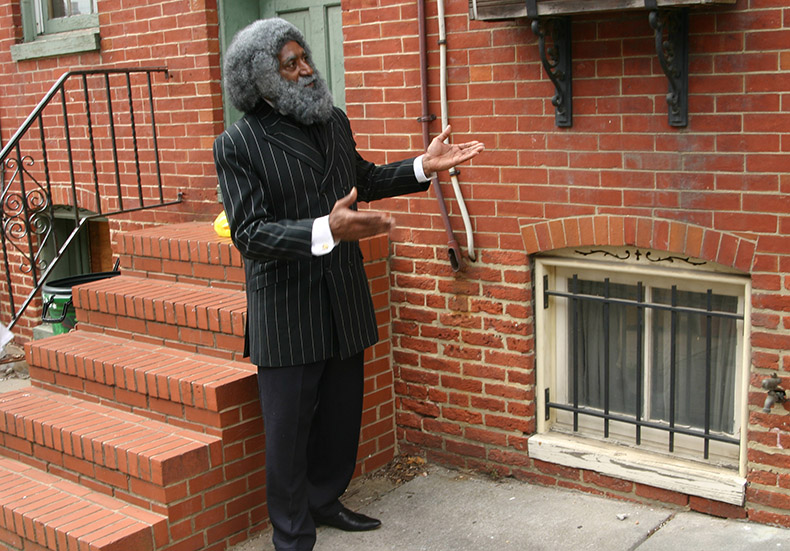
Frederick Douglass tribute actor in front of one of his houses in Fells Point; (c) Soul Of America
Baltimore History
When Maryland was one of the original British colonies in the early 1700s, Baltimore was the fourth largest city. Even at its founding, African-Americans had a major presence in the city. Our presence was seen in the Revolutionary War fought in and around Baltimore. Due to the British first offering freedom to escaped slaves, African-Americans fought on both sides of this war and remained in the city afterward.
Perhaps the most remarkable characteristic of Baltimore was that it had so many Black churches beginning in the late 1700s. Hampton Estate, just north of Baltimore, has a Georgian Manor house, gardens, tobacco plantation and former slave quarters. By the late 1750s, Hampton Estate extended to more than 10,000 acres, plus an ironworks.
Since the 1800s, African American watermen, also known as “Black Jacks”, have been fishing for seafood in the Chesapeake Bay. Most of them lived near Baltimore. At a time when many of the nation’s Black men and women were still enslaved, many Black Jacks were given “Seaman Protection Certificates.” That gave them status as American citizens and allowed them to earn legal wages. Throughout the 19th and 20th centuries, these fishermen caught and processed seafood like oysters and crabs alongside their white counterparts.
While slavery was legal in the city, free African-Americans developed churches and other organizations to assist their persecuted brothers and sisters. In fact, there was an order of magnitude more free persons of color in Baltimore than in any other Southern city. The African Methodist Episcopal Conference took place in the city in 1827, and the famous St. James Episcopal Church was founded in 1827. The first Black private school for girls, the Oblate Order, was founded in 1829.
Frederick Douglass worked the docks of Fells Point in East Baltimore and Harriet Tubman passed through many times on her sojourns.
By 1850, there were over 25,000 free persons of color in the city, comprising 15% of the city population. They set up 30 to 40 mutual aid societies for business, fraternity, welfare, and insurance. After the Civil War, African-Americans opened the Centenary Biblical Institute, which became a hub of African-American culture and activism. Today, it has become Morgan State University.
In 1885, the Baltimore Mutual United Brotherhood of Liberty was founded. This organization used the courts to pursue civil rights for African-Americans. In 1892, the Baltimore Afro-American Newspaper was founded. It is one of the longest-standing black newspapers and is still published. Soon afterward, Paul Lawrence Dunbar High School and Frederick Douglass High School were formed.
In the early 1900s, Jim Crow was meeting all challenges. The 1910 purchase of a row house at 1834 McCulloh Street by W. Ashbie Hawkins, an African American, flew in the face of the understood racial demarcation line. It prompted Baltimore City Council to pass four residential segregation laws between 1910 and 1913. When the U.S. Supreme Court declared this method unconstitutional in 1917, more racially restrictive covenants and redevelopment became the local instruments of discrimination.

Fort McHenry in Baltimore; (c) Soul Of America
In response to these forms of Apartheid, Baltimore developed the nation’s second-biggest NAACP branch. Their activism led to many incremental victories and a strong reputation in the fight for national civil rights. One example is their important role in the 1948 protest that desegregated Baltimore’s public facilities, such as tennis courts. Baltimore’s progressive reputation attracted many African Americans from the South.
Swelling with immigration, by 1958 African Americans comprised over 50% of Baltimore public schools. A heavy dose of real estate redlining ensued. Conditions were ripe for the 1968 riots and fair housing laws to trigger White-Flight to the suburbs without replacement of their middle-class tax base. The same story played out in New York, Chicago, Detroit, Philadelphia, Los Angeles, Cleveland, St. Louis, and other cities.
By 1970, Baltimore had a clear Black majority, albeit poorer, that elected Parren J. Mitchell to the US Congress 7th district. Mitchell led Congress to establish the first Minority Business Development program. When Mitchell retired, Kweisi Mfume, a street hustler-transformed-to-activist, and radio talk show host was elected in his place. Mfume would go on to distinguish himself as the head of the Black Caucus and NAACP. In the 1980s, Baltimore elected its first Black mayor and Rhodes Scholar, Kurt Schmoke, who continued the strategy of building up the Inner Harbor tourism tax base. Baltimore’s stature as a national tourist and convention destination grew, even as neighborhood problems festered. Nevertheless, the city became the national headquarters for the NAACP.
After 12 years of Schmoke’s leadership, Martin O’Malley, a European American, was elected mayor with support from black elected officials. Elijah Cummings became the second Congressman from Baltimore to lead the Black Caucus.
By any measure, the Inner Harbor, Fells Point, Mount Vernon, Camden Yards, and South Baltimore tourism districts are resounding successes. Urban professionals are returning to those districts in droves, escalating housing prices. The Westside of Downtown is on a similar turnaround path. Now the city must focus its strategy and resources on the renewal of West Baltimore and East Baltimore to turn around the part of its image seen on The Wire TV program.
Today, the Black Jacks could catch 50 bushels of crabs per day. Today they only catch two or three bushels. Look for Captain Meredith on Chesapeake Bay fishing charters to keep the memory of his Black Jack ancestors alive.
